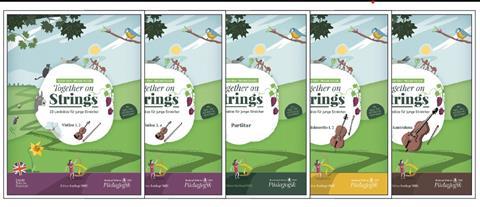Celia Cobb goes through Esther Klein and Michael Dartsch’s collection of 23 ‘German and international’ song arrangements for young string players

Together on Strings
Esther Klein, Michael Dartsch
Violin 1, 2 43pp ISMN 9790004187128 £12
Violin 3, 4 35pp ISMN 9790004189627 £12
Viola 1, 2 43pp ISMN 9790004187135 £12
Cello 1, 2 38pp ISMN 9790004187142 £12
Double bass 26pp ISMN 9790004187159 £12
Score 64pp ISMN 9790004187111 £27
Edition Breitkopf
Together on Strings is a collection of 23 ‘German and international’ song arrangements for young string players. Each piece is arranged for six independent parts – two violins, two violas and two cellos. The viola parts are available in alternative treble clef versions and the second cello part is also available as a separate double bass part. The books themselves are immaculately printed and edited; there is a conductor’s score, containing all six parts (as well as a treble clef version of the first viola part), and there are five separate part books: Violins 1 and 2; Violas 1 and 2; Violins 3 and 4; Cellos 1 and 2; and Double Bass. There are full-colour illustrations on every page of music in the parts and, usefully, because the tunes are shared reasonably fairly between the upper string parts, the main melody sections are printed in blue ink. The score also contains ideas for additional group exercises including improvisation and listening activities.
The overall sound world of this ensemble music is slightly different from your average arrangements for beginner ensemble, which are usually in three or four parts, and generally come with a ‘cover all bases’ piano part. Here there is no piano accompaniment or short score reduction, and as the parts are largely independent, all six would be needed for a successful performance. The ‘extra’ parts are often used to great effect – in one piece, Poli, poli, olizisti, the second violas play a tapped drum-like ostinato while a repeated drone figure in 5ths in the cellos imitates a hurdy-gurdy; in another, Leise rieselt der Schnee, three pizzicato parts represent the falling snow while the other parts play the tune, a harmony part and a bass-line. The thick harmonies and busy textures created by the large number of parts mean that in the hands of beginners, it is possible that the main tunes might occasionally struggle to come through clearly, even though dynamic markings are used carefully and thoroughly throughout.
Read: Book review: Classical Music for Children: 22 Easy Pieces for Violoncello and Piano
Read: How young is too young when starting children on the violin?
Watch: The Strad panel discussion: making music fun for kids
Despite the English title of the series, the books are printed in German, with an English translation available for download from the publisher’s website. Unfortunately, English versions of the song texts given in the score are generally not provided (even though German translations are given for songs with Italian, English, Hebrew and French texts), which is rather a shame for those who are not fluent German speakers. The arrangements often imaginatively incorporate something do to with the text of the song into one or other of the parts, and the absence of an English translation makes this playful creativity (representations of howling wind, a creeping fox, some buzzing bees etc.) less obvious. It also makes it more difficult for non-German speakers to sing the songs before playing them.
The authors suggest that the pieces are suitable ‘from one year of lessons onwards’ and although at first glance the use of basic rhythm patterns with notes entirely in first position would seem to confirm this, the arrangements are, in reality, fairly complex for beginners. There are staggered entries, pauses, changes of tempo and time signatures, not to mention anacruses, off-beat accompaniment figures and a fair few tricky bowings. Tackling this repertoire would be a pretty ambitious project for a group of beginners. However, this publication would be an excellent resource for slightly more advanced players needing to develop their ensemble skills. Used in this context, this varied collection of arrangements would provide perfect training material for children to get to grips with essential ensemble playing skills, in particular maintaining an independent part while listening to everything else happening around them. It would be ideally suited for violinists and viola players of around Grade 2–3 standard, and cellists and bassists of around Grade 1+.
CELIA COBB



































No comments yet